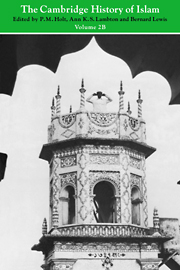Book contents
- Frontmatter
- Introduction
- PART VIII ISLAMIC SOCIETY AND CIVILIZATION
- 1 THE GEOGRAPHICAL SETTING
- 2 THE SOURCES OF ISLAMIC CIVILIZATION
- 3 ECONOMY, SOCIETY, INSTITUTIONS
- 4 LAW AND JUSTICE
- 5 RELIGION AND CULTURE
- 6 MYSTICISM
- 7 REVIVAL AND REFORM IN ISLAM
- 8 LITERATURE
- (a) ARABIC LITERATURE
- (b) PERSIAN LITERATURE
- (c) TURKISH LITERATURE
- (d) URDU LITERATURE
- 9 ART AND ARCHITECTURE
- 10 SCIENCE
- 11 PHILOSOPHY
- 12 WARFARE
- 13 THE TRANSMISSION OF LEARNING AND LITERARY INFLUENCES TO WESTERN EUROPEo
- Dynastic List
- Bibliography
- Glossary
- Index
- References
(a) - ARABIC LITERATURE
from 8 - LITERATURE
Published online by Cambridge University Press: 28 March 2008
- Frontmatter
- Introduction
- PART VIII ISLAMIC SOCIETY AND CIVILIZATION
- 1 THE GEOGRAPHICAL SETTING
- 2 THE SOURCES OF ISLAMIC CIVILIZATION
- 3 ECONOMY, SOCIETY, INSTITUTIONS
- 4 LAW AND JUSTICE
- 5 RELIGION AND CULTURE
- 6 MYSTICISM
- 7 REVIVAL AND REFORM IN ISLAM
- 8 LITERATURE
- (a) ARABIC LITERATURE
- (b) PERSIAN LITERATURE
- (c) TURKISH LITERATURE
- (d) URDU LITERATURE
- 9 ART AND ARCHITECTURE
- 10 SCIENCE
- 11 PHILOSOPHY
- 12 WARFARE
- 13 THE TRANSMISSION OF LEARNING AND LITERARY INFLUENCES TO WESTERN EUROPEo
- Dynastic List
- Bibliography
- Glossary
- Index
- References
Summary
Arabic literature in its entirety and in the restricted sense is the enduring monument both of a civilization and of a people. Originally the creation of the pastoral nomads of the Arabian peninsula, it had been in pre-Islamic times the literature of an isolated Semitic community when the Arab conquests in the first/seventh century gave it a new role and a universal significance. Its linguistic medium, the ‘arabiyya, the sacred and administrative language of the Arab Muslim empire, developed into the common literary idiom of the various peoples of that empire, and the literature expressed through this common idiom became the most important cultural constituent in medieval Islamic civilization. This literature stimulated the rise, and influenced the development, of a new literary family, that of Islamic literatures represented by Persian, Turkish and Urdu. Its geographical diffusion in three continents enabled it to leave important traces on several non-Islamic literary traditions; for Europe and the Mediterranean region it became, along with the other two classical literatures, Greek and Latin, an integral part of the medieval complex.
The fortunes of this literature in classical times were closely affected by two external factors. The ruling institution exercised, on the whole, an unsalutary influence on its course, as court patronage restricted the freedom of the literary artist and circumscribed the range of his interests. On the other hand, the religious institution rendered it inestimable services. The doctrine of i‘jāz,the inimitability of the Qur’ān, ensured interest in Arabic literature and literary criticism as the key to the understanding of that doctrine, but it was indirectly that the religious institution made its more permanent contribution.
- Type
- Chapter
- Information
- The Cambridge History of Islam , pp. 657 - 671Publisher: Cambridge University PressPrint publication year: 1977



